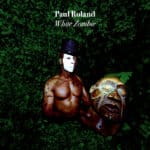L’ ossessione di Paul Roland per il film White Zombie del 1931, con Bela Lugosi come protagonista, vero cult del cinema voodoo, lo ha portato negli anni ’90 a scrivere le basi di quella che avrebbe dovuto essere la colonna sonora del film, riscritta da Roland. Si trattava di musica perlopiù strumentale, con canti e cori che dipingevano la schiavitù di questi uomini ridotti dallo scienziato folle a zombie, automi per aumentare la forza lavoro nelle fabbriche. Un tema, piuttosto attuale, fuor di metafora… Parlandone una sera a cena con il produttore Max Marchini nasce l’idea di rielaborare i nastri originali trasfigurandoli in qualcosa di davvero inedito e originale per la lunga e onorata carriera del songwriter inglese. Secondo la scuola di Dark Companion, della quale Unifaun Productions è sussidiaria, la musica pop di Roland ha subito un processo di rivisitazione con percussioni tribali che rimandano a “Eskimo” dei Residents, chitarre oblique e spezie avant-garde che hanno impreziosito i canti, avvalendosi anche della collaborazione di musicisti e amici italiani tra i quali citiamo la vocalist d’avanguardia Paola Tagliaferro che ha contribuito alla musica incidentale rivestendo la voce solista della Gran Sacerdotessa. Tra gli ospiti Annie Barbazza, già colaboratrice di Greg Lake e John Greaves, Paolo Tofani degli Area, i Warm Morning Brothers, Lorenzo 3k Trecordi, Camillo Mozzoni (l’oboe di Lino Capra Vaccina), Beppe Lombardo e altri ancora. I chants sono riusciti talmente bene che hanno spinto Roland a scrivere delle nuove canzoni straordinarie sul tema voodoo dal sapore vagamente psichedelico alle quali i sopracitati musicisti hanno saputo dare una veste davvero sorprendente, tanto da aver fatto dichiarare a Roland che questo White Zombie è il lavoro che lo ha più soddisfatto in tutta la sua carriera. Un album di musica nuova, davvero diversa ma pur immediatamente riconoscibile sotto al raffinatissimo “trademark” del padre dello Steampunk, ovvero mr. Paul Roland, registrato e mixato da Alberto Callegari ai mitici studi Elfo di Tavernago, per un suono da dimostrazione HI-FI. Vedi recensioni e ascolta alcuni brani in: http://www.darkcompanion.com/copia-di-up002-paul-roland
***
One sultry summer evening in 1994, I had the pleasure of talking with Dr John, ‘The Night Tripper’ (aka Mack Rebenneck), about his early life in New Orleans and his initiation into the cult of voodoo. many years later as my fascination with voodoo was then purely academic (at the time I was writing a book on comparative religions, ‘Revelations-The Wisdom of the Ages’.) I had played with voodoo themes on an early song of mine ‘Jumbee’ and was to do so again with ‘Voodoo Doll’, but I didn’t get serious with Baron Samedi until very recently. I don’t know what possessed me (as we say in England) but something certainly did over the course of a few days when I succumbed to the temptation to experiment with singing along to drum patterns rather than writing ‘conventional’ songs by working The secrets he shared with me that day I didn’t put into practice until through a sequence of chords on an instrument. To my surprise as soon as I opened my mouth something entirely unexpected came out. They were raw, primitive chants sung ‘in tongues’ (ie wordless sounds) which soon formed ‘verses’ and chorus’ like the call and response hymns that Baptist congregations produce when the spirit moves them, or as I imagine our forebears created when moved by the nature, animal and ancestor spirits they worshiped. I didn’t stop until I had exhausted all rhythmic variations and had 22 complete chants. I then added simple counter melodies and answering phrases on flute, organ and marimba. It was only later that a friend and practicing shaman, told me that this was a common ritualistic practice that shaman call Power Songs. But what to do with them? I took my rough demo/sketches to a film composer acquaintance who recreated them note-for-note in preparation for what I imagined would be a voodoo themed soundtrack to the 1932 Bela Lugosi film ‘White Zombie’ which had very little music but wonderful imagery. The film soundtrack didn’t get made but the project haunted me and when I eventually met Italian rock journalist Max Marchini and was invited to join his illustrious company of artists and compatriots, I naturally took the opportunity to see if we could complete this long cherished album. I then wrote French lyrics to fit the chants and was fortunate to have a French friend, Cathy Viale, to help me translate them into creole as well as a superb female vocalist and dear friend, Paola Tagliaferro, to sing them with the gravitas that the role of the High Priestess required. Fortunately, Max also succeeded in persuading me to write some new songs on the same subject and resurrect a couple of unreleased songs that I had only demoed at that point. My ‘primitive’ voodoo chants became the core of a more ambitious and fully realized album thanks to a large ‘family’ of musicians like Paolo Tofani, Annie Barbazza, The Warm Morning Brothers, Lorenzo, Beppe, Sergio, Yuston, Max and Alberto themselves, who gave their time and talents so generously. And of course to Dr John, who I suspect was with me in spirit when Dumbahla spoke




